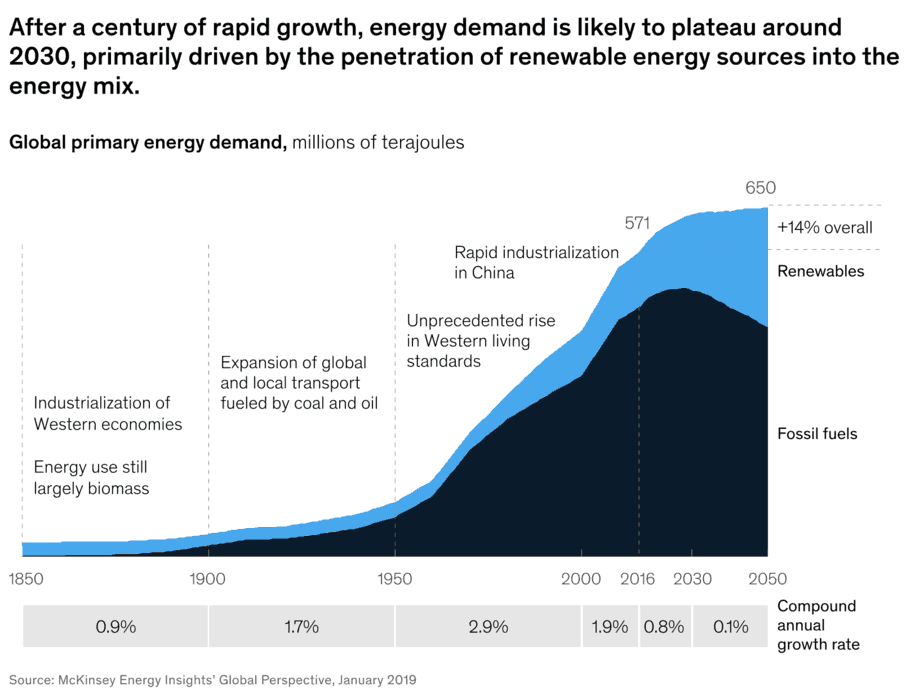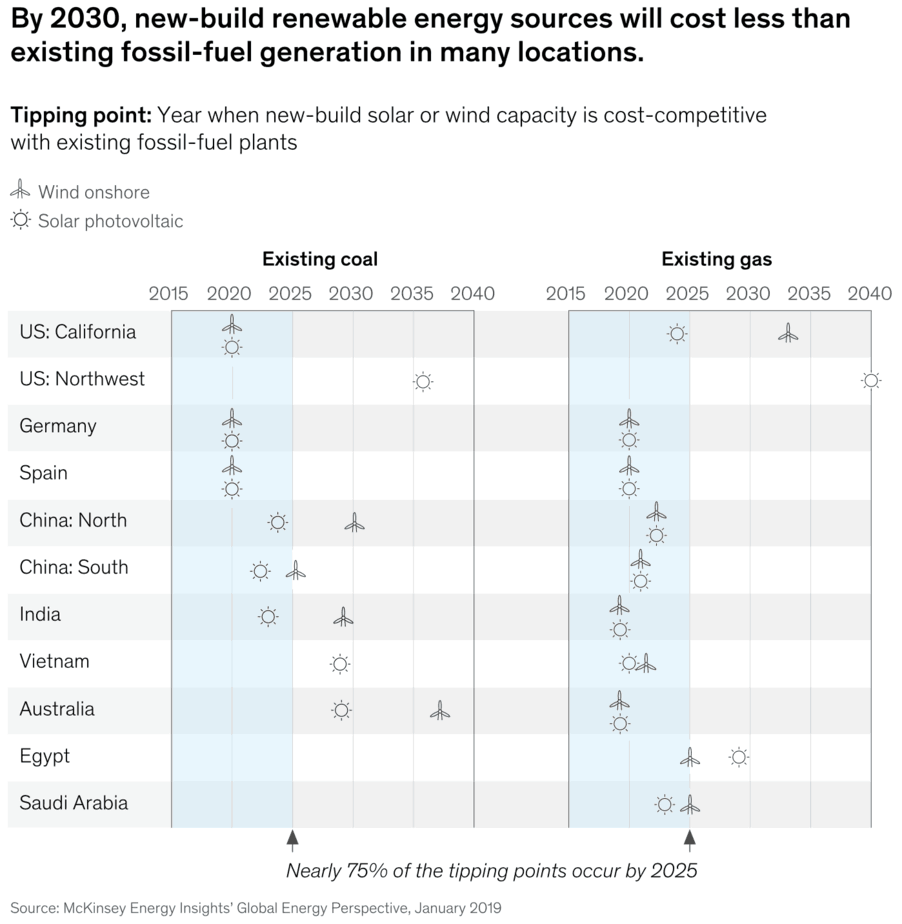McKinsey zeigt, wie Technologie die Lösung ist
Technologie und Innovation sind die Lösung, nicht Verbote und Enthaltsamkeit. Schon gar nicht Deindustrialisierung hierzulande. Beispiel heute, eine aktuelle Studie von McKinsey. Und jetzt mag man von Beratern halten, was man will, rechnen können sie:
- “Our latest global energy perspective — part of a multiyear research effort examining the supply and demand of 55 types of energy across 30 sectors in some 146 countries — suggests that we’re beginning to see a decoupling between the rates of economic growth and energy demand, which in the decades ahead will become even more pronounced.” – bto: Wir werden also effizienter. Das unterstreicht, was ich auch sage: Es wird immer über Technologie gelöst werden, nicht von Politikern.
- “Energy demand has long tracked economic growth. So much so that for the past two centuries, the amounts of energy that economies need have increased virtually in lockstep with the amounts of wealth that economies create. (…) at the turn of the 20th century, rates of both energy demand and economic growth took off. From 1900 to 1950 — as horses gave way to cars, oil lamps to electric lighting, and ice boxes to refrigerators — primary energy demand nearly doubled. Economic growth rates soared as well; in the United States (by far the largest economy in the world), GDP per capita in 1950 was more than twice that of 1900.” – bto: Und die “grüne” Logik – nur durch Verzicht auf Lebensstandard ließe sich dies umkehren – ist falsch. Zwar mag man das so sehen mit Blick auf die Geschichte, aber es muss nicht so sein und zeugt von einer tiefgehenden Technikfeindlichkeit und Ignoranz.
Quelle: McKinsey
- “(…) our analysis suggests that while a more populous world will create more wealth than ever, energy demand rates will plateau and demand rates for fossil fuels will begin to decline worldwide. How can that be?” – bto: und genau das rechnet McKinsey dann vor:
- “The decoupling of the rates of economic growth (climbing steadily) and energy demand growth (ascending, but less steeply) will largely be a function of the following four forces:
- a steep decline in energy intensity of GDP, primarily the consequence of a continuing shift from industrial to service economies in fast-growing countries such as India and China
- a marked increase in energy efficiency, the result of technological improvements and behavioral changes
- the rise of electrification, in itself a more efficient way to meet energy needs in many applications
- the growing use of renewables — resources that don’t need to be burned to generate power — a trend with the potential not only to flatten the primary energy demand curve but also to utterly change the way we think about power.”
– bto: Ja, da taucht auch der Begriff der “Verhaltensänderung” auf. Es ist aber nicht der Fokus. Richtig so.
- “(…) advances in LED lighting, smart appliances, and other applications will substantially lessen the energy intensity of households worldwide. In more developed countries — and to an extent, globally — changes in users’ mind-sets will also boost efficiency. Not only are people beginning to be more conscious about their behavior (such as turning off lights and air conditioners when they’re not in use), they’re benefitting from innovations such as automatic sensors and controlled devices, which eliminate the bother of worrying about such things.” – bto: Man will ja nicht unbedingt Energie verbrauchen, wenn es nicht nötig ist. Klare Sache.
- “Within the global buildings segment, energy intensity will decline as new, energy-efficient technologies are adopted. As a result, the energy needs per capita at a global level will be 10 percent less in 2050 than they were in 2016, despite the rapid rise in demand from the many households entering the middle class in emerging economies. And the transportation sector will realize some of the most dramatic efficiencies of all. The shift to electric vehicles (EVs), combined with improvements to internal-combustion-engine (ICE) vehicles, means that overall energy needs for road transport will increase only slightly — even while the total number of cars and trucks on the world’s roads will likely more than double.” – bto: außer natürlich in Deutschland, wo man in der Rückkehr zum Fahrrad den einzigen Weg sieht, die Welt zu retten …
- “Given forecasted declines in electric-battery costs, passenger-car EVs could reach cost parity with their ICE-powered counterparts before 2025, with many larger types of vehicles reaching price parity soon thereafter. The rise of EVs will not only shift demand from petroleum, it will also curb the total amount of energy required for road transportation. For passenger cars, electric motors require less than one-third the energy as ICE motors for every kilometer driven.” – bto: Das hängt natürlich von der Laufleistung ab, gegeben den CO2-Ausstoß bei der Herstellung.
- “The growth of renewables is essential to understanding why the primary energy demand curve will level off between now and 2050. (…) Of course, these types of renewable energy need to be captured and stored. Technological improvements to solve those challenges and reduce costs substantially, however, are in process. The levelized cost of energy (that is, the net present value of the unit cost of electricity over an asset’s lifetime) for renewables has been declining remarkably during the past two decades. We expect that by 2020, wind and solar generation will be cheaper than electricity generated conventionally by new-build coal and natural-gas plants, almost everywhere. By 2025, renewables should be competitive even with the marginal cost of just running existing conventional plants in many countries and regions (Exhibit 2). Our analysis further suggests that renewables, including wind, solar, and also hydro power, will provide more than half of the world’s electricity by 2035.” – bto: was die Wirkung von Technologie unterstreicht. Hier sollte man drauf setzen.
Quelle: McKinsey
- “An important implication is that global energy-related emissions, compared with 2016 levels, should fall by approximately 20 percent by 2050. That’s significant, but not decisive. Absent more aggressive action, the current reductions in emissions by some countries won’t be enough to put the world on the ‘two-degree pathway’ deemed essential by the 2016 Paris Agreement. It’s quite possible, therefore, that governments will implement more substantive policies to meet emissions targets.” – bto: vermutlich. Ich denke allerdings, dass es weitere Möglichkeiten geben wird, um den CO2-Gehalt in der Atmosphäre zu senken. Auch hier ist Technologie die Lösung.
→ mckinsey.com: “The decoupling of GDP and energy growth: A CEO guide”, April 2019









